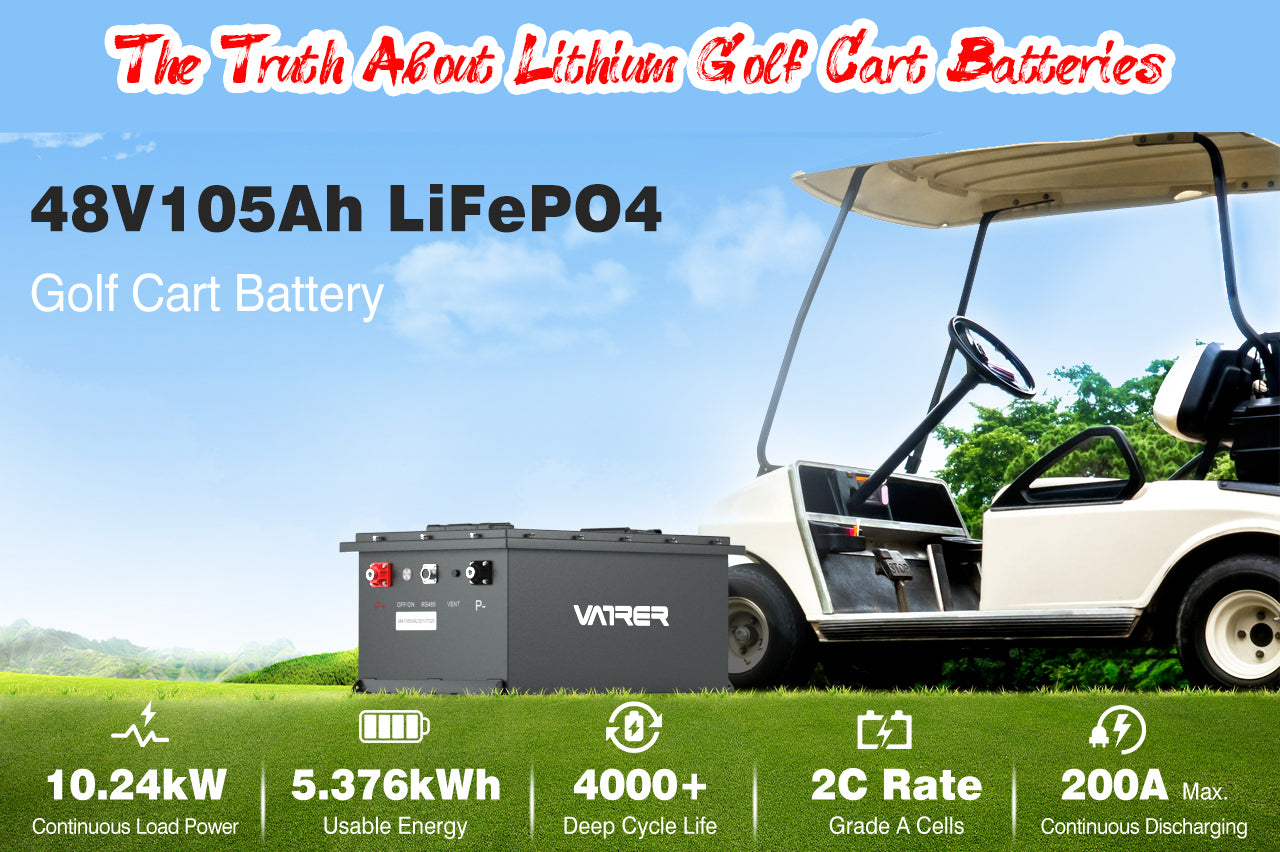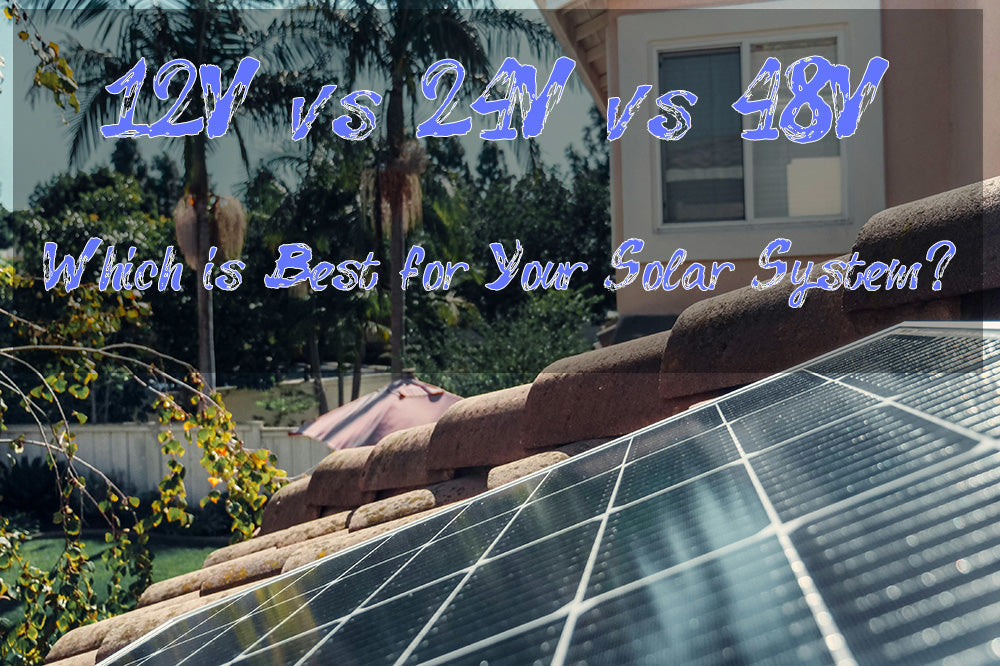Golf carts are a common means of transportation on golf courses. The choice of their power system will directly affect your driving experience or fleet operating costs. Compared to traditional lead-acid batteries, lithium-ion batteries have become increasingly popular with golf cart owners in recent years due to their longer lifespan, lighter weight, and faster charging speeds. They have become a mainstream feature in golf carts.
High initial costs and specialized maintenance requirements often confuse golf cart owners considering upgrading to EZGO or Club Car lithium batteries. This article explores the pros and cons of lithium-ion batteries for golf carts, helping you, whether you're an individual or a fleet manager, effectively mitigate potential risks and extend their lifespan.
What Role Do Lithium Batteries Play In Golf Carts?
As lightweight electric vehicles, golf carts have unique requirements for power batteries. Lithium batteries, such as the 48V or 72V golf cart lithium batteries, can significantly enhance golf cart performance.
Compared to traditional lead-acid batteries, lithium batteries offer advantages such as higher energy density, longer cycle life, and lower maintenance requirements.
Commonly used lithium batteries consist of a positive electrode, a negative electrode, an electrolyte and a separator, and store and release electrical energy through the movement of lithium ions between the positive and negative electrodes.
The high energy density of lithium golf cart batteries allows the cart to travel farther with the same amount of lead-acid battery power. You can also equip the cart with a smaller battery, such as the Vatrer Mini 48V battery, to reduce the weight of the entire vehicle according to different mileage requirements. In addition, the charging speed of lithium batteries is significantly faster than that of lead-acid batteries, which greatly shortens the charging waiting time and improves the efficiency of the golf cart.
What Are The Disadvantages Of Golf Cart Lithium Batteries?
Although lithium batteries have many advantages, they also have some disadvantages. Below, the Vatrer team will discuss and explain these limitations in detail, thereby providing practical suggestions for more golf cart owners.
1. High Upfront Cost of Lithium Batteries
Lithium batteries of the same specifications are typically two to three times more expensive than traditional lead-acid batteries. For example, the upfront cost of a 48V golf cart lithium battery is $1,500 to $3,500, while lead-acid batteries cost only $500 to $1,200. This price difference makes many car owners reluctant to purchase these batteries.
This cost difference is mainly due to the high prices of raw materials used in lithium batteries, such as lithium, cobalt, and nickel, and the complex battery management system that increases the overall cost. The details are as follows:
Raw material costs: Key components in lithium batteries, such as positive electrode materials (such as lithium iron phosphate or ternary materials), negative electrode materials (graphite), electrolyte (lithium salt solution), and separators, are relatively expensive. The use of cobalt in ternary lithium batteries, in particular, further increases costs, as cobalt is a scarce and concentrated mineral resource.
Technical costs: Lithium battery production requires a highly clean environment with strictly controlled temperature and humidity, requiring significantly more investment in production equipment and energy consumption than lead-acid batteries. Furthermore, the use of lithium batteries in groups requires a sophisticated battery management system (BMS) to monitor and protect the batteries from overcharging, over-discharging, and other issues, further increasing overall costs.
Economic analysis: Although the initial cost of lithium batteries is high, from the perspective of full life cycle costs, lithium batteries are more economical. Lithium batteries typically have a cycle life 3-5 times that of lead-acid batteries. While lead-acid batteries typically experience significant capacity degradation after 300-500 charge-discharge cycles, high-quality lithium golf cart batteries can achieve over 3,000 cycles. This means you may need to replace two or three groups of lead-acid batteries over their lifetime.
Maintenance and Electricity Costs: Lithium batteries require virtually no maintenance, while lead-acid batteries require regular electrolyte level checks and distilled water replenishment, resulting in higher maintenance costs. Furthermore, lithium batteries offer higher charging efficiency and lower energy conversion losses, resulting in relatively lower electricity costs over the long term.
You can refer to the following table for the estimated cost of lithium batteries and lead-acid batteries within 5 years, which can help you take long-term cost budgets into account when making your initial budget:
Battery Type
Lithium battery (48V)
Lead-acid battery (48V)
Initial purchase cost
$1,500-$3,500
$500-$1,200
Number of battery replacements (within 5 years)
0 times
2 times
Battery replacement cost
0
$1,000-$2,400
Estimated maintenance cost
$50
$300
Estimated electricity cost
$400
$600
Total cost over 5 years
$2,000-$4,500
$2,500-$4,500
Despite the higher initial cost of lithium batteries, their infrequent replacement and simplified maintenance mean their total cost of ownership over five years is lower than that of lead-acid batteries. For golf courses or resorts with high usage, it would be more economical to purchase golf cart batteries. For those with infrequent golf cart use, the initial cost advantage of lead-acid batteries may be more attractive.
2. Lithium Batteries' Temperature Sensitivity
Compared to traditional lead-acid batteries, lithium batteries have a relatively narrow operating temperature range, and performance and safety risks are more pronounced when used in low or high temperature environments. Temperature not only affects the immediate performance of lithium batteries, but also their long-term lifespan.
At low temperatures, the chemical reaction rate within lithium batteries is significantly reduced, the electrolyte's fluidity deteriorates, and lithium ions become difficult to insert and extract from the electrode materials. This significantly reduces the battery's available capacity, limits output power, and may even render it impossible to charge.
When ambient temperatures fall below 32°F (0°C), the discharge capacity of a lithium battery can drop by 20%-30%. At temperatures as cold as -4°F (-20°C), some low-quality lithium batteries may only deliver half of their rated capacity.
For golf courses in areas with cold winter temperatures, this means golf carts can have significantly reduced range or be unable to provide sufficient power at critical moments. More seriously, forcing a lithium battery to charge at low temperatures can cause lithium metal dendrites to form on the negative electrode surface, piercing the separator and causing a short circuit, significantly increasing safety risks.
High temperatures are equally detrimental to lithium batteries. When temperatures exceed 113°F (45°C), side reactions within the battery intensify, the electrode material's structural stability deteriorates, and the electrolyte decomposes more rapidly. This not only accelerates battery capacity degradation but can also trigger a chain reaction of thermal runaway. In the hot summer months, the internal temperature of a golf cart's lithium battery pack parked outdoors can exceed the ambient temperature, especially during the charging process. If heat isn't effectively dissipated, the battery temperature will rise further. Prolonged exposure to high temperatures can shorten the cycle life of a lithium battery by more than half.
The following information illustrates the performance changes of lithium batteries at different temperatures:
Temperature Range
Capacity Change
Power output capability
Charging efficiency
Lifespan impact
Below -4° F (-20° C)
Decrease of more than 50%
Severely limited
Charging prohibited
Negative electrode damage
14° F to 32° F (-10° C to 0° C)
Decrease of 20%-30%
Significantly reduced
Extremely low efficiency
Minor impact
32° F to 77° F (0° C to 25° C)
Normal
Normal
Normal
Minimal
77° F to 113° F (25° C to 45° C)
Normal
Normal
Slightly reduced efficiency
Accelerated degradation
Above 113° F (45° C)
Temporary increase
May be limited
Reduced efficiency
Significantly shortened
To address the temperature sensitivity of lithium batteries, you can implement the following strategies:
Temperature Management System: High-end golf cart lithium battery packs are equipped with active or passive temperature control systems. Active systems use heating and cooling devices, such as electrothermal film and liquid cooling pipes, to precisely control battery temperature. Passive systems rely on insulation and heat dissipation design to mitigate temperature fluctuations. For carts used in areas with large temperature fluctuations, consider Vatrer self-heating cart batteries. These batteries also feature a battery management system (BMS) protection function that automatically activates heating when the temperature drops below 32°F (0°C) and stops heating when the temperature rises to 41°F (5°C)
Preheating Before Use: In low-temperature environments, preheat the lithium battery using an external power source or the battery's built-in heating function. Wait until the temperature reaches the optimal range of 41°F (5°C) before discharging or charging. This significantly improves low-temperature performance and prevents damage to the battery.
Shading and Insulation: In hot weather, park in a cool, shady area, out of direct sunlight. In colder weather, consider wrapping the battery pack in an insulating cover to slow heat loss. Some golf carts feature specialized battery compartment insulation for even better results.
Adjust your charging and discharging strategies: Avoid high-rate charging in hot weather and reduce high-current discharge in cold weather. Adjust your usage to accommodate temperature limits. Some lithium battery management systems (BMS) automatically adjust charging and discharging parameters based on temperature, providing enhanced protection.
Choose the right battery type: Different types of lithium batteries have different temperature characteristics. For example, lithium iron phosphate (LFP) batteries offer better stability at high temperatures than ternary lithium batteries, while specially designed lithium-ion batteries offer better low-temperature performance. Choose the appropriate battery type based on your region's climate.
It's important to note that the effects of temperature on batteries are cumulative. Even if a single low-temperature exposure or high-temperature exposure doesn't cause noticeable problems, long-term temperature stress can still accelerate battery aging. Therefore, in daily golf cart use, it's important to develop good temperature management habits and avoid exposing the vehicle to extreme environments for extended periods. Additionally, regular battery health checks, particularly changes in capacity and internal resistance, can help identify temperature-related damage early and allow for remedial measures.
3. Safety Hazards of Lithium Batteries
Compared to traditional lead-acid batteries, lithium batteries present unique safety hazards such as the risk of thermal runaway, susceptibility to mechanical damage, and difficulty in fire extinguishing. Once these safety issues occur, they can not only cause property damage but also threaten personal safety, and therefore require serious attention.
The core safety risk of lithium batteries is thermal runaway. This is a chain reaction triggered by overheating: high temperatures cause the separator inside the battery to melt, resulting in direct contact and a short circuit between the positive and negative electrodes. This in turn generates further heat, decomposes the electrolyte to produce flammable gases, and decomposes the positive electrode material to release oxygen, ultimately causing the battery to catch fire or even explode.
Thermal runaway can be triggered by a variety of factors, including overcharging, over-discharging, external short circuits, internal short circuits, mechanical damage, and high temperatures. In the case of lithium batteries used in golf carts, the following conditions are particularly dangerous:
Overcharging: Continuing to charge beyond the battery voltage limit can lead to lithium metal precipitation at the negative electrode and oxidative decomposition of the electrolyte.
Deep discharge: Excessively low voltage causes the negative electrode copper current collector to dissolve, and upon further charging, copper dendrites may form at the positive electrode.
External short circuit: A conductive object simultaneously contacts the positive and negative electrodes, such as a metal tool dropped between the battery terminals, resulting in a sudden, high current and high heat.
Internal short circuit: A damaged separator or lithium dendrites piercing the separator result in direct contact between the positive and negative electrodes. This can be caused by manufacturing defects or long-term aging.
Mechanical damage: A collision or puncture damages the battery's physical structure, often occurring in traffic accidents or improper handling.
High temperature: Ambient temperatures exceeding safety thresholds accelerate internal side reactions in the battery, such as when stored in a closed vehicle during summer.
The following table compares the safety characteristics of lithium and lead-acid batteries. Whether you're planning to replace your lithium battery or are currently using lead-acid batteries, it will help you better understand the safety risks associated with each.
Safety Features
Lithium batteries
Lead-acid batteries
Thermal Runaway Risk
High, difficult to control if an event occurs
Very low
Electrolyte Flammability
Organic electrolyte is highly flammable
Sulfuric acid solution does not burn
Pressure Buildup
Possible, especially with sealed designs
Controlled by a pressure relief valve
Overcharge Hazard
Extremely high, may cause fire
Generates hydrogen gas, potentially explosive
Leakage Hazard
Electrolyte is toxic and flammable
Sulfuric acid is highly corrosive
Fire Suppression
Requires large amounts of water for internal cooling
Conventional fire extinguishers are effective
To further mitigate lithium battery safety risks, you can implement the following multi-layered protective measures:
Battery Management System (BMS): This is the core of a lithium battery pack's safety, offering multiple protections. A high-quality BMS precisely monitors the voltage and temperature of each cell, controls the charge and discharge currents, and immediately shuts off the circuit if an anomaly is detected. Advanced BMSs also feature cell balancing to prevent overcharging and overdischarging caused by inconsistent cell status within the pack. You can address this issue by switching to a Vatrer golf cart battery. Our batteries are equipped with powerful BMS functionality and support Bluetooth connectivity for real-time battery status monitoring via an app.
Physical Protection Design: Lithium battery packs for golf carts are typically protected by a sturdy outer casing, with fireproof and heat-insulating materials between the cells. The battery pack's mounting location is also carefully designed, typically located under or at the rear of the vehicle to minimize collision risk. High-end lithium battery designs, such as those found on Vatrer batteries, also incorporate pressure relief devices to prevent internal pressure buildup and explosion.
Safety Certifications: Choose lithium batteries from manufacturers like Vatrer that have achieved international safety certifications such as CE and RoHS. These certifications ensure that the batteries have passed rigorous abuse tests, such as puncture, crushing, overcharge, and over-discharge. Avoid using cheap, uncertified batteries, which may offer attractive prices but carry significant safety risks.
Proper Use and Storage: Always strictly follow the lithium battery's instructions, use the original LiFePO4 charger, and avoid charging in extreme temperatures. If not used for an extended period, maintain the battery capacity at 50%. Regularly inspect the battery's exterior and connectors. If impacted or submerged in water, discontinue use immediately and have the battery inspected by a professional.
Emergency Preparedness: Lithium battery storage or charging areas should be equipped with specialized fire extinguishing equipment, such as a Class D fire extinguisher or a large water supply. Maintain good ventilation and keep away from flammable materials. Develop an emergency plan.
It's important to emphasize that with the continuous advancement and maturity of lithium battery technology, new battery materials are improving these safety issues. For example, lithium iron phosphate (LFP) positive electrode material is more resistant to high temperatures than ternary materials and is less likely to cause thermal runaway. Solid-state electrolytes can completely solve the problem of flammable electrolytes, and self-healing diaphragms can prevent lithium dendrites from penetrating.
4. Complex Battery Management Systems for Lithium Batteries
The use of lithium batteries in golf carts relies on a key component: the Battery Management System (BMS). This system not only guarantees the performance advantages of lithium batteries, but also introduces additional complexity and potential problems. Unlike simple and durable lead-acid batteries, lithium batteries have extremely stringent operating conditions, requiring a BMS to constantly monitor and regulate them, acting like a 24/7 babysitter for the battery pack.
The core functions of a battery management system include fuel monitoring, charge and discharge control, temperature regulation, and cell balancing. Fuel monitoring accurately measures voltage, current, and temperature to estimate the battery's remaining capacity (SOC) and state of health (SOH). Charge and discharge control prevents overcharge and overdischarge by limiting current and disconnecting the circuit.
Temperature regulation maintains an appropriate operating temperature by activating heating or cooling devices. Cell balancing adjusts the charge level of each cell to maintain a consistent state within the battery pack. These functions require high-performance hardware sensors and complex control algorithms. Failures in any of these components can lead to degraded battery performance or safety hazards.
The primary challenge posed by the complexity of the BMS is system reliability. The BMS itself is composed of electronic components. Potential failures include: voltage detection circuit drift leading to inaccurate SOC estimation, current sensor malfunction leading to ineffective charge and discharge control, and temperature sensor damage leading to insufficient overheat protection. These issues are not uncommon in real-world use and are often difficult to detect until the battery exhibits obvious abnormalities. Furthermore, BMS failures can lead to chain reactions. For example, incorrect balancing control can accelerate cell inconsistency within the battery pack, impacting overall performance and lifespan.
Compatibility Issues: Lithium-ion battery packs and chargers from different manufacturers may experience communication protocol mismatches, especially when using a charger from a different manufacturer than the battery. This incompatibility can lead to inefficient charging, inability to fully charge the battery, and even damage the battery. Common issues include fault code indications and charging interruptions after changing lithium-ion battery brands, which are often indicative of compatibility issues.
Required Professional Repair: When lithium-ion battery packs experience problems, standard repair shops may lack the specialized equipment and skills to diagnose and repair BMS failures. Unlike simple lead-acid battery maintenance, lithium-ion battery repairs require specialized diagnostic tools to read fault codes and, in some cases, a computer connection for software resets or upgrades. This specialized work makes lithium-ion battery repairs more expensive and time-consuming, and qualified service centers can be difficult to find in remote areas.
Software Issues: Modern BMS increasingly rely on software algorithms, particularly for SOC estimation and cell balancing control. Software flaws can lead to systematic errors that are difficult for non-professionals to update or fix. In some cases, abnormal battery performance may simply be due to a BMS software upgrade, rather than a hardware failure.
To reduce maintenance challenges, we recommend the following practical strategies for managing BMS complexity:
Regular diagnostics: Use specialized equipment, such as a lithium battery analyzer, to check SOC accuracy, balancing effectiveness, and temperature sensor deviation every six months.
Compatibility management: Choose batteries and chargers that support common communication protocols (such as CAN 2.0B) to avoid interoperability issues between brands.
Thermal management system optimization: For golf carts used in high-temperature areas, battery packs equipped with liquid cooling or forced air cooling, such as Vatrer batteries, should be preferred to reduce the pressure on BMS temperature control.
Software maintenance: Update BMS firmware promptly to fix known defects. Some manufacturers offer remote OTA updates.
You can also maintain your golf cart lithium battery BMS according to the maintenance cycle recommendations below:
Maintenance measures
Inspection Details
Duration
Tools/Methods
Voltage consistency
Cell voltage deviation ≤ 0.05V
1 month
Multimeter or diagnostic tester
Temperature sensor
Temperature difference between reading and actual temperature ≤ 2°C
3 months
Infrared thermometer comparison
Balance function
Voltage difference change after full charge and rest
6 months
Charge and discharge tester
Communication link
CAN bus impedance and noise level
1 year
Oscilloscope testing
Conclusion
While lithium golf cart batteries offer many advantages, they also present challenges, such as high upfront costs, specialized charging requirements, high temperature sensitivity, complex voltage output, and several safety concerns. Understanding the drawbacks of lithium-ion batteries and implementing appropriate maintenance strategies, such as regular battery management system (BMS) inspections and storage at a constant temperature and humidity, can mitigate these drawbacks and ensure a longer battery life.
If you're looking for lithium-ion golf cart batteries for sale near you, Vatrer's 48V 100Ah lithium-ion battery is an excellent choice for Club Car and EZGO golf carts. We offer deep-cycle batteries with a 5-10 year lifespan and the safety of a robust BMS.
























































